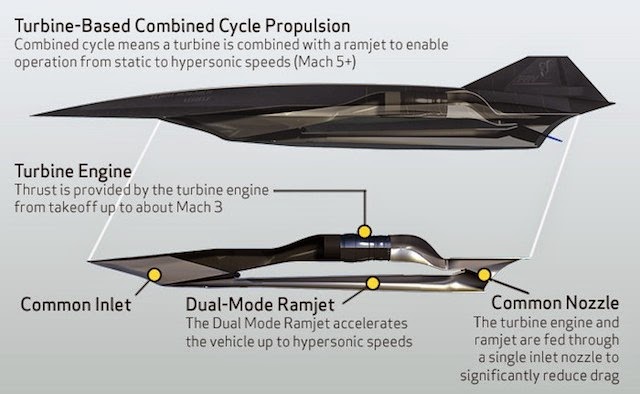
NASA has funded a parametric design study to establish the viability of a Turbine Based Combined Cycle (TBCC) Propulsion system consisting of integrating several combinations of near-term turbine engine solutions and a very low Mach ignition Dual Mode RamJet (DMRJ) in the SR-72 vehicle concept.
The SR72 would fly at speeds of Mach 6.0, or 4,500 mph. That’s almost double the speed of the Lockheed SR-71 Blackbird, which made its first flight 50 years ago.
Lockheed Martin is working with Aerojet Rocketdyne to find a way to integrate a turbine engine, which would get the plane upto Mach 3, with a supersonic ramjet engine, or scramjet, to push it to Mach 6.
Lockheed believes it can develop its SR-72 by 2030.
The $892,292 contract funds a design study to determine the viability of a TBCC propulsion system by combining one of several current turbine engines, with a very low Mach ignition Dual Mode Ramjet (DMRJ).
NASA previously funded a Lockheed Martin study that found speeds up to Mach 7 could be achieved with a dual-mode engine combining turbine and ramjet technologies. The problem with hypersonic propulsion has always been the gap between the highest speed capabilities of a turbojet, from around Mach 2.2 to the lowest speed of a ramjet at Mach 4. Typical turbine engines cannot achieve high enough speeds for a ramjet to take over and continue accelerating.
The NASA-Lockheed study is looking at the possibility of a higher-speed turbine engine or a ramjet that can function in a turbine engine’s slower flight envelope; the DARPA HTV-3X had demonstrated a low-speed ramjet that could operate below Mach 3. Existing turbofan engines powering jet fighters and other experimental designs are being considered for modification. If the study is successful, NASA will fund a demonstrator to test the DMRJ in a flight research vehicle.
Source: Next Big Future
